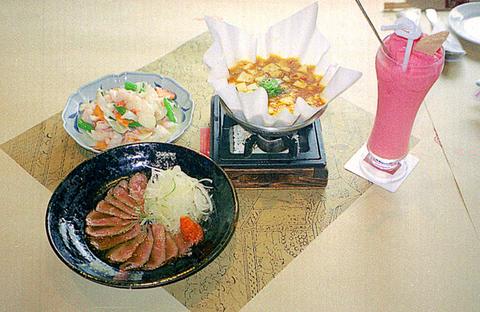The term "modern Chinese cuisine" might not mean much to those who haven't sampled the fare at Taipei's People restaurant (人間), but for the thousands who have frequented the dimly lit yet fashionably chic joint, then the term conjures up images of plates of food that boast a fusion of colors and the truly tantalizing taste explosions that accompany the restaurant's fantastic cuisine.
According to People's manager, Daphne Hua (華昌德), the secret of the joint's continued success lays with People's chefs' ability to blend modern ideas with age-old recipes. Open to the adaptation of simple home-style Chinese cooking, the origins of every dish on the menu lay with those that have been knocked out in kitchens across China for generations.
Not that diners would ever guess that the food they are munching on is of the same ilk as that cooked in homes nationwide. The combination of colors ensures that every dish fashioned in the kitchens of the People restaurant appears almost good enough to frame and hang on the wall. And with no MSG or artificial flavorings added to any of the food the taste remains as pure as nature intended.

PHOTO: GAVIN PHIPPS, TAIPEI TIMES
Keeping the foodstuffs' original taste certainly doesn't make for blandness, however, as People's combination of ingredients means that even the simplest of dishes is a sheer pleasure. Along with the appearance and taste, a meal at the People's won't break the bank or empty your wallet.
Moderately priced and too numerous to list in full, some of the restaurants' most popular dishes include deep-fried chicken slices with lime sauce (檸檬雞片) (NT$300), stir-fried sirloin slices on a pottery plate (陶盤牛肉) (NT$320), simmered sea-bass belly with soy sauce (燜燒魚肚膛) (NT$360), spicy bean curd in a paper pot (人間豆腐) (NT$250) and the interestingly named Buddha's meal (羅漢齋) (NT$280).
Along with a fine selection of savory dishes, the menu also includes an extensive drink list, with the wide selection of cocktails, liquors, beers, teas, coffees and soft drinks all as moderately priced as the food.
While the menu currently lists upwards of 120 dishes, in one month this is set to be cut back to 80. The reason behind People's decision has nothing to do with the seemingly never-ending economic downturn, however. Restaurant management has instead decided to cut the number of dishes on offer in order that the quality of the most popular cuisine can be refined and, if in deed possible, improved upon.

US President Donald Trump may have hoped for an impromptu talk with his old friend Kim Jong-un during a recent trip to Asia, but analysts say the increasingly emboldened North Korean despot had few good reasons to join the photo-op. Trump sent repeated overtures to Kim during his barnstorming tour of Asia, saying he was “100 percent” open to a meeting and even bucking decades of US policy by conceding that North Korea was “sort of a nuclear power.” But Pyongyang kept mum on the invitation, instead firing off missiles and sending its foreign minister to Russia and Belarus, with whom it

Many people noticed the flood of pro-China propaganda across a number of venues in recent weeks that looks like a coordinated assault on US Taiwan policy. It does look like an effort intended to influence the US before the meeting between US President Donald Trump and Chinese dictator Xi Jinping (習近平) over the weekend. Jennifer Kavanagh’s piece in the New York Times in September appears to be the opening strike of the current campaign. She followed up last week in the Lowy Interpreter, blaming the US for causing the PRC to escalate in the Philippines and Taiwan, saying that as

When Taiwan was battered by storms this summer, the only crumb of comfort I could take was knowing that some advice I’d drafted several weeks earlier had been correct. Regarding the Southern Cross-Island Highway (南橫公路), a spectacular high-elevation route connecting Taiwan’s southwest with the country’s southeast, I’d written: “The precarious existence of this road cannot be overstated; those hoping to drive or ride all the way across should have a backup plan.” As this article was going to press, the middle section of the highway, between Meishankou (梅山口) in Kaohsiung and Siangyang (向陽) in Taitung County, was still closed to outsiders

The Chinese Communist Party (CCP) has a dystopian, radical and dangerous conception of itself. Few are aware of this very fundamental difference between how they view power and how the rest of the world does. Even those of us who have lived in China sometimes fall back into the trap of viewing it through the lens of the power relationships common throughout the rest of the world, instead of understanding the CCP as it conceives of itself. Broadly speaking, the concepts of the people, race, culture, civilization, nation, government and religion are separate, though often overlapping and intertwined. A government